#cimetière du pere Lachaise
Text
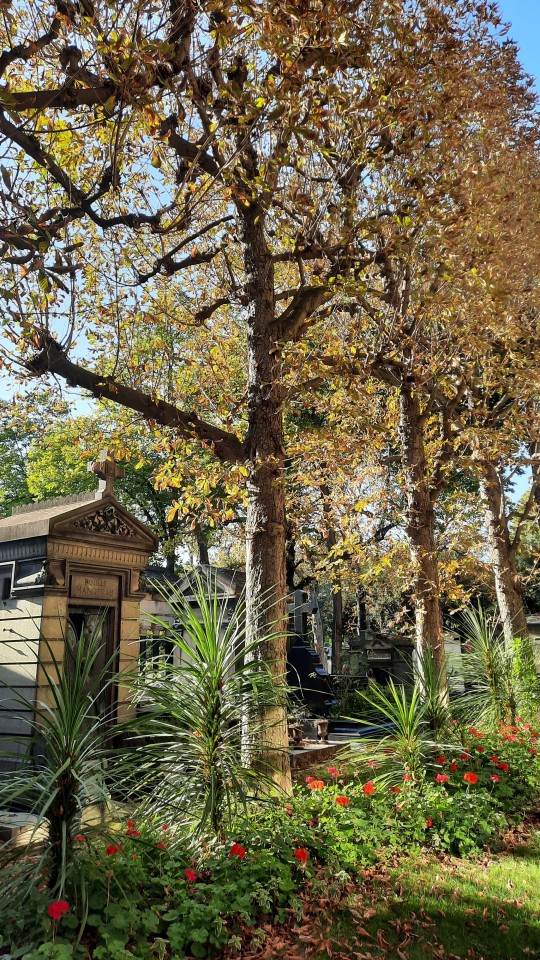
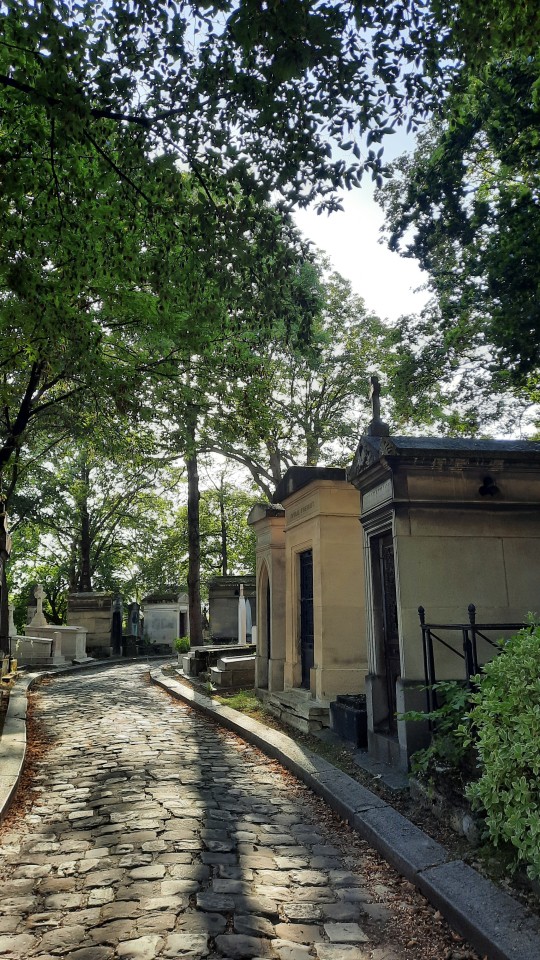
Cimetière du Père Lachaise, Paris, octobre 2023.
#cimetière#cimetiere#cemetery#pere lachaise#cimetière du pere Lachaise#paris#paris xi#paris 11#xi arrondissement#france#automne#autumn#death#mort#catholiscism
16 notes
·
View notes
Text

The gorgeous Nö Eelys in Père-Lachaise cemetery.
Photo @lo.fotografi
#no_eelys#pere lachaise#gothic style#gothic elegance#gothic beauty#french cemetery#Cimetière du Père Lachaise#paris#france
6 notes
·
View notes
Photo

ANECDOTE | Lapins traqués par un chasseur au cimetière du Père-Lachaise en 1870 ➽ http://bit.ly/Lapins-Pere-Lachaise À la fin du XIXe siècle, un brocanteur chasse le lapin en plein coeur du cimetière du Père-Lachaise, déjouant les pièges tendus par les gardiens durant 10 ans, bravant condamnations et peines de prison dont il écopa sans que cela n’entame une rage de s’amuser qui le conduisait parfois à passer des nuits entières, dehors, par d’abominables temps
7 notes
·
View notes
Text
Some differences between the translations in Chapter 105.
The older translator seems to have found M. de Villefort's thoughts about cemeteries a bit disrespectful:
M. de Villefort, parisien pur, regardait le cimetière du Père-Lachaise comme le seul digne de recevoir la dépouille mortelle d'une famille parisienne; les autres lui paraissaient des cimetières de campagne, des hôtels garnis de la mort. Au Père-Lachaise seulement un trépassé de bonne compagnie pouvait être logé chez lui.
M. de Villefort, a true Parisian, considered the cemetery of Pere–la–Chaise alone worthy of receiving the mortal remains of a Parisian family; there alone the corpses belonging to him would be surrounded by worthy associates.
M. de Villefort, a pure Parisian, considered the Père-Lachaise cemetery the only one worthy of receiving the mortal remains of a Parisian family. The others appeared to him like country cemeteries, death's lodging-houses. Only in the Père-Lachaise could the respectable departed be accommodated at home.
I don't often say this when the translators disagree on the meaning of a passage, but in this case I think the older translator might have a better grasp of what Dumas is saying:
C'étaient presque tous des jeunes gens que la mort de Valentine avait frappés d'un coup de foudre, et qui, malgré la vapeur glaciale du siècle et le prosaïsme de l'époque, subissaient l'influence poétique de cette belle, de cette chaste, de cette adorable jeune fille enlevée en sa fleur.
These last consisted of all the young people whom Valentine’s death had struck like a thunderbolt, and who, notwithstanding the raw chilliness of the season, could not refrain from paying a last tribute to the memory of the beautiful, chaste, and adorable girl, thus cut off in the flower of her youth.
Almost all were young men who had been forcibly struck by Valentine's death and who, despite the cold mists of the century and the prosaic spirit of the age, felt the elegaic poetry of this beautiful, chaste, adorable young woman, struck down in her prime.
And finally, the obituaries:
Quelques hommes, et comme toujours, c'étaient les moins impressionnés, quelques hommes prononcèrent des discours. Les uns plaignaient cette mort prématurée; les autres s'étendaient sur la douleur de son père; il y en eut d'assez ingénieux pour trouver que cette jeune fille avait plus d'une fois sollicité M. de Villefort pour les coupables sur la tête desquels il tenait suspendu le glaive de la justice; enfin, on épuisa les métaphores fleuries et les périodes douloureuses, en commentant de toute façon les stances de Malherbe à Dupérier.
A few men, the least impressed of all by the scene, pronounced a discourse, some deploring this premature death, others expatiating on the grief of the father, and one very ingenious person quoting the fact that Valentine had solicited pardon of her father for criminals on whom the arm of justice was ready to fall—until at length they exhausted their stores of metaphor and mournful speeches.
A few men – and, as always, the least impressive – made speeches. Some regretted this premature death, others expatiated on her father's grief. Some had been found who were ingenious enough to have discovered that the young woman had more than once implored M. de Villefort on behalf of guilty men over whose head the sword of justice was suspended. Finally, every flowery metaphor and tortuous syntactical device was exhausted in every type of commentary on the lines written by Malherbe to du Périer.
(Buss explains in a footnate that François de Malherbe was a poet in the 16th century whose famous works include "Consolation to M. du Périer, gentleman of Aix-en-Provence, on the death of his daughter".)
#the cristo account#the count of monte cristo#chapter 105#lost in translation#spoilers#the count of monte cristo spoilers#not a reblog
14 notes
·
View notes
Text
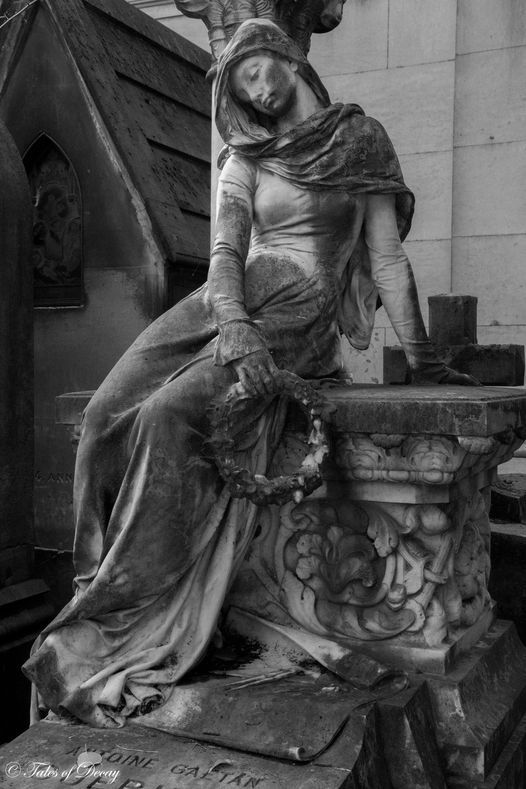
Cimetière du Pere Lachaise, Paris
© Tales Of Decay
9 notes
·
View notes
Photo

Can’t escape the cemetery this first week of November. Paths in the cemetery Pere Lachaise, Paris. . . . #paris #cemetery #perelachaisecemetery #parisjetaime #parislife #parisart #parismonamour #parismaville #parislove #pariscity #villedeparis #iloveparis #parisfind (at Cimetière du Père-Lachaise, Paris, France) https://www.instagram.com/p/CkiTWY7rKly/?igshid=NGJjMDIxMWI=
#paris#cemetery#perelachaisecemetery#parisjetaime#parislife#parisart#parismonamour#parismaville#parislove#pariscity#villedeparis#iloveparis#parisfind
4 notes
·
View notes
Text
Post #2: On Pere Lachaise Cemetery
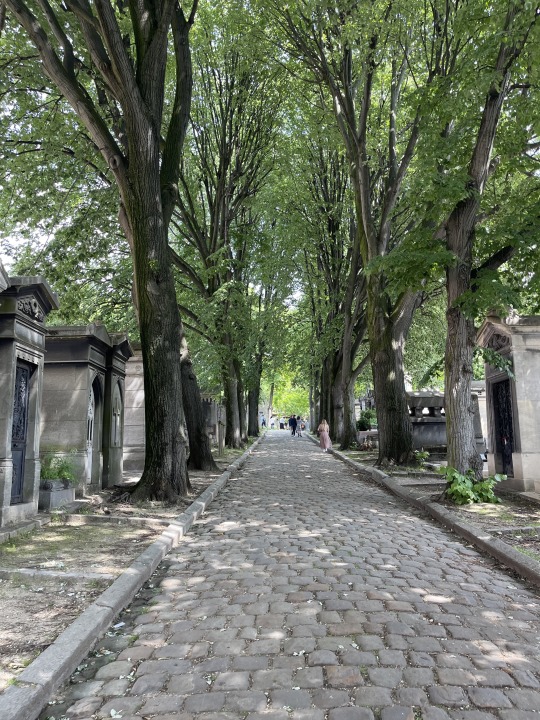
Overall, experiencing Pere Lachaise was very interesting as I had never spent an extended period of time in a cemetery and had never been to one as large or historic as this. This is a place of many memories as it holds so many people who have passed and memorializes many others that were unable to be buried at the cemetery. The Paris Commune in 1871 saw several victims in this cemetery after they lost a battle and were shot against a wall within the cemetery. There are also many famous individuals buried at this cemetery which increases the number of visitors who come to remember those who have passed. Walking along the cobblestone paths amongst the tombs and memorials was something that was very interesting as I was very aware that I was in a place of remembrance that must be respected. While walking through the pathways and up the hills, I came to an overlook with flower beds that had the appearance of a park. This was something that was unexpected as I did not think of this cemetery as a place where people would spend time outside of remembering those who had passed. The cemetery was a beautiful place overall with its trees, historic tombs, flowers, and cobblestone paths but it is also important to remember its true purpose as a cemetery. There was a lot of diversity in the tombs as there were more simplistic tombstones, large memorials for individuals or groups of individuals, and mausoleums. It was interesting to consider why some individuals had more extravagant burial places and we speculated that it could have been the result of wealth. It was also interesting to see which tombs had flowers or other things on them and which were left empty or were left in disrepair.
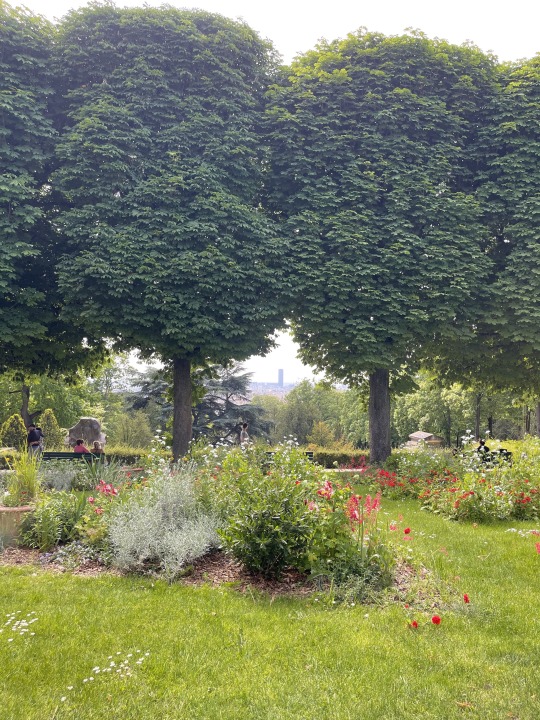
The Holocaust memorials at the Pere Lachaise cemetery were particularly striking and heartbreaking to see. The specific area dedicated to those lost in the Holocaust houses fifteen memorials, for each of the deportation and death camps (1). During the Nazi occupation of Paris and the Second World War, 75,000 Jewish people were deported and sent to camps with many of them losing their lives. There are memorials specifically dedicated to Dachau, Auschwitz, Buchenwald, Oranienburg and Sachsenhausen where many Jewish people throughout Europe were deported, many of which lost their lives in the camps (2). Several of these memorials depict skeletons or imagery of death to recognize the horrors that so many were forced to go through at these camps. In particular there were two memorials that were located next to each other that I found to be very striking. The first memorialized the Jewish children who were killed by the Nazi’s during world war two and depicts human-like shapes shown in metal. The anonymity of the figures helps to show that many of the victims of these horrors are still unknown and that they are being memorialized as they are not buried in this spot. Next to it is a memorial for two concentration camps, Buna-Monowitz and Auschwitz, remembering the lives lost at these sites. This memorial depicts five skeleton-like figures in bronze, all with fatigued body language and with one being wheeled. This shows the suffering and horrors that the victims of these camps had to go through in their time. Walking through this area of the cemetery was a somber experience but an important one as the horrors that so many Jewish people had to undergo must be remembered. (582 Words)
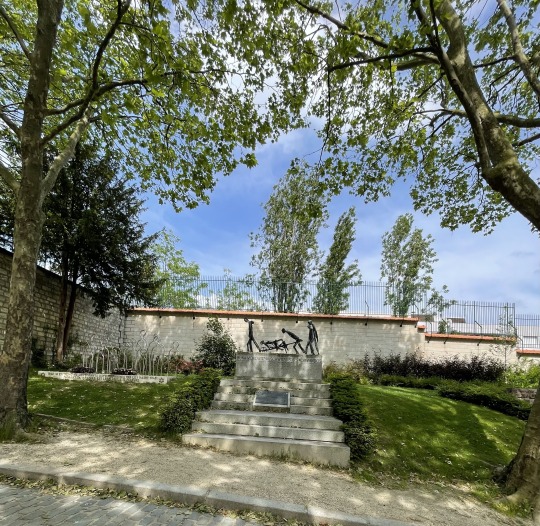
(1) “Cimetière Du Père-Lachaise : Un Haut Lieu de Mémoire.” n.d. Accessed May 25, 2023. https://www.paris.fr/pages/cimetiere-du-pere-lachaise-un-haut-lieu-de-memoire-17725.
(2) “Holocaust Memorials at Père Lachaise Cemetery, Paris, France.” 2015. Historic Houston: (blog). June 26, 2015. http://historichouston1836.com/holocaust-memorials-at-pere-lachaise-cemetery-paris-france/.
0 notes
Text
12.08.22
A DREADED SUNNY DAY
We’d marked Friday as the day to have a little picnic at the Eiffel Towel, an evening picnic, so after eating an okay falafel in Le Marais for lunch (i’ve had better in brunny) we bought a few cheeses and meat from some pretty delis for later. At the cheese shop the plan was to buy one hard and one soft, but with the little french we had between us we resolved to pointing at one that looked hard and one that looked soft to take to Champ de Mars, with no idea what kind of cheese we’d be eating. On the way back to the airbnb I split from my company to visit the famous cemetery down the hill from where we were staying. I’d hitherto spent many hours in the cemeteries of the cities and towns I’d visited, however none as illustrious as the Cimetière du Père Lachaise, resting place of Chopin, Seurat, Proust, Modigliani, et al. I had a lot of time to work with as I wasn’t picnicking with the others until sunset, and it was a sweet and warm afternoon. I took myself to the monoprix by the necropolis’ southern entrance and browsed the beer fridge. A tall, scruffy, and skinny man of about my age joined me in contemplating the various bottles chilling in front of us. He was wearing a poncho over his meek shoulders, thus giving his appearance the effect of a folded standing umbrella. He asked me, in french, if I spoke english and I replied and nothing else, in english.
He selected a large and dark bottle from the fridge with a gaudy label containing scrawling (french) writing and three plump tomatoes. He asked me if I had tried this before (I hadn’t), if it was beer made from tomatoes (I supposed), and what I thought of it (sounds gross). We continued our conversation beyond his peculiar drink choice and he mentioned that he was on the way up to the cemetery to visit a grave. I mentioned I was heading there too so we bought our beers and strolled up to the cemetery gates. It was a stinker of a day for my companion - he just learned he’d received a speeding fine back home in Bristol, the last he was allowed before licence rescission, and that this was a disaster as he lives in his van and, as his parents just moved to Paris, he will now have nowhere to live. As a remedy he wanted to have some beers by the tomb of his hero: Jim Morrison.
My knowledge of Jim Morrison doesn’t go much further than his leading of The Doors, and his intense bon vivant lifestyle that lead to an early death, in Paris (one must either have lived in or died in Paris to be buried at Pere Lachaise). Mon ami passionately filled my Jim Morrison lacuna as we walked to the grave, finding it enclosed by graffiti-laden steel temp fencing around it and an array of flowers, letters, photographs and random knick knacks, such as small dog trinkets. The Bristolian was such a fan of the lizard king that he had committed multiple Morrison poems to memory, reciting one to me by the graveside. I offered to take a photo of him standing by the grave, a grave mistake indeed as I got sent back on three occasions before he was happy with the shot (and note we were not the only visitors at the time). I called on my friend to follow me up to what I thought was the cemetery’s main attraction, the tomb of Oscar Wilde. We broke on through to the other side of the cemetery where the great Sphinx-like sculpture levitates above its neighbours. One of the more renown tombs of the world, the tomb of Oscar Wilde is not just famous due to the dandy lying within, but its design, the controversy surrounding its construction and the ongoing engagement or vandalism, depending how ya brain works, by Wilde fans makes it a very intriguing site. The tomb, a great block of stone with a kind of naked sphinx carved out of it, had various priggish detractors when it was announced it would be living in the cemetery, and the sculptor, Jacob Epstine, was given fines and hurdles to jump over from hostile police when installing it. The angelic sphinx originally had genitals where a man would usually have them, but Epstine returned to the site one day of working on it to find the testicles covered by plaster. Compromise with the police was reached when Wilde’s executor agreed a bronze butterfly would be installed to cover the testicles. Epstine did not give permission for the artwork to be altered and refused to attend the unveiling, leaving the unveiling to Aleister 'The Great Beast' Crowley, of all people. It’s said that a short time later Crowley approached Epstine at a Paris cafe to let Epstine know his problem had been fixed: around Crowley’s neck hung a necklace with the castrated butterfly balancing in its centre.
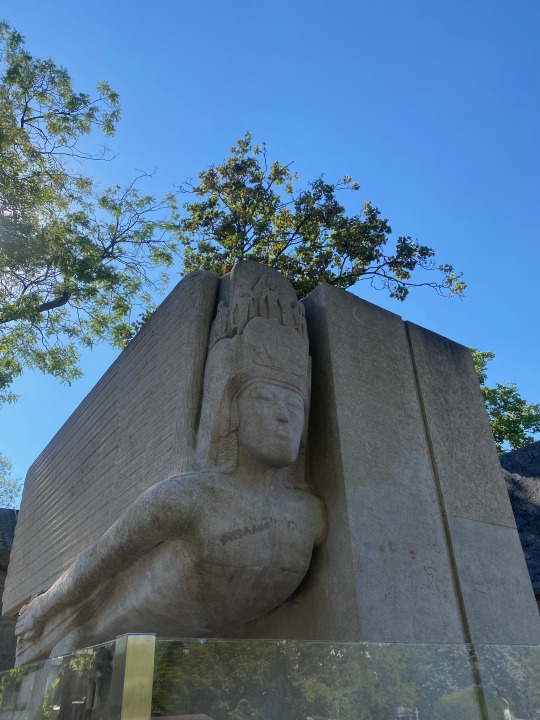
As Wildes name and reputation progressed from scandalous to marvellous, the tomb began to apply makeup. For years visitors made their own mark on the grave by kissing it with red lipstick and liner. After a while it was realised the lipstick, and its irregular removal, was causing damage to the stone, but nothing was done about it. This adoration went on for years to the point where the tomb’s erosion was so bad that longevity was genuinely at risk, and in 2014 a glass casing was installed around it. Those who still want to kiss the stone can do so by climbing on the neighbouring grave and jumping up, and a smattering of kisses were there on my visit, for each man kills the thing he loves. All this and more was pontificated to my fellow traveller, a little bit of payback for earlier. By now the shadows from the tombs were starting to stretch across the cemetery streets so, worried about my infamous unpunctuality and time taken to get ready to go out, I thanked my companion and wishing him well headed back to the accom.
Showered, shaved and pampered for our picnic we borrowed some wine glasses from the accommodation and smashed all but one of them in our backpack on the way to there. We came armed with champagne and the aforementioned cheese and meats and sat on the grass watching many successful proposals. Both the cheeses were soft, and one of the cheeses smelt and tasted so abhorrently it had to be removed and disposed of far away. As is common in many touristy spots, walking salesmen with ciggies, buckets of iced beer and champagne patrol the area. While we were stocked up to begin with, the champagne went down with the sun and before long we were flagging the gallic Willy Loman down and paying too much for his champagne; ice cold and brought direct to your lap, we were not protesting.

Reading us well, our champagne salesman began to make half hourly stops past our bivouac, where he’d prosper consistently, albeit for less euros each time. One bottle went then came two then three, then four and many more and then it was 5 and we thought we’d probably had a good look at the Eiffel tower by now, surrendering to the sunrise.
1 note
·
View note
Text
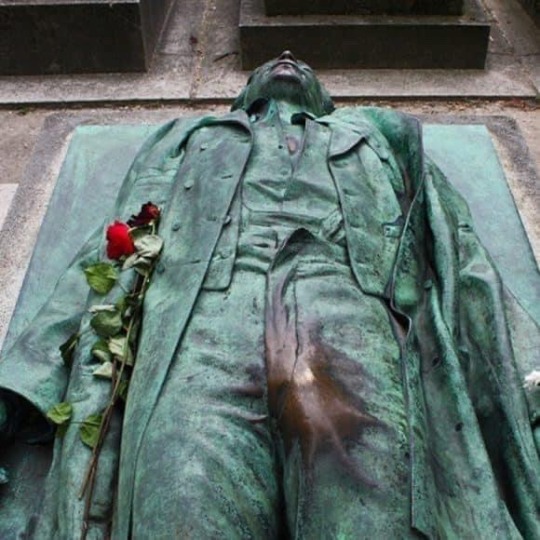
Today’s glimpse of French history:
The Recumbent Effigy of Victor Noir
Cimetière du Père Lachaise
Paris, France
Victor Noir's effigy gets more action than the man himself ever did 😳
EUROPEAN FUNERAL ART HAS GIVEN many artists the opportunity to explore their own style by experimenting with the idea of an everlasting memorial. What image should remain as an eternal monument linking the absence of a human being and the sorrow of their family?
In his photographic journey “Erotique du Cimetiere”, contemporary artist and funeral art specialist Andre Chabot offers a wonderful reflection on how voluptuous female nude statues became the ultimate symbol of mourning, appeasing our wounded souls through the sensuality of their curves. But if femininity is a common motif in French cemeteries, the grave of Victor Noir and the incongruous folklore that surounds its effigy offers new possibilities in the Eros equation.
Victor Noir, a 19th-century political journalist, is one of those people who will be better remembered in death than in life. Shot in a duel by Prince Pierre Bonaparte in 1870, he became a symbol of the imperial injustice and a martyr for the Republic. More than one hundred thousand people came to his funeral, where frenetic weeping was mixed with calls for insurrection. After the downfall of the Second Empire, Victor Noir’s remains were transferred to the Pere Lachaise Cemetery, and a bronze effigy was commissioned to the sculptor Jules Dalou in praise of his memory.
Noir was depicted as an elegant man, lying dead on the floor after the impact of the lethal bullet, his top hat tipped over on his side. Dalou chose to represent Noir in a very realistic way, his face having the detailed quality of a cast death mask. However, another detail of Noir’s anatomy would soon get more attention than the sober realism of the memorial bronze. The dead Victor, in his eternal sleep, bears an under-belt bump that a lot of his living fellows would be jealous of.
Victor Noir is nowadays one of the most visited residents in the graveyard, right after Jim Morrison and Allan Kardec. His popularity is not because of his talent as a journalist, nor his symbolic role, but lies in the notorious lump in his pants. A generation of superstitious (or just randy) women have decided that taking indecent rubbings of Victor’s impressive girth could prevent infertility, and perform these rubbings in more than the traditional manner.
After a century of daily joyrides (even burlesque dancer Dita Von Teese had a go) Victor Noir’s lips and groin are shiny and nickel-clean, while the rest of his body presents the greenish tone of oxidized bronze. In 2004, when a fence was erected around Victor Noir’s tomb to deter fertility-seekers from carnally touching the statue, women were so offended that a few noisy protests were staged in the cemetery, enough to have the fence torn down 😱 x x
Source - Atlas Obsura
1 note
·
View note
Text
Entry 2: On Pere Lachaise Cemetery
For my second blog assignment, I decided to embark on the metro and visit Pere Lachaise Cemetery on a rainy Sunday morning. Pere Lachaise is the largest cemetery in Paris, and is one of the largest green spaces in the city. It covers 43 hectares, features over 70,000 burial plots, including many famous people and historical figures, and contains several monuments. The cemetery was opened in 1804 to replace unsanitary parish conditions, and to give more burial spaces.


Upon walking into Pere Lachaise, I was immediately struck by how different it felt compared to a cemetery that you could find in the United States. In Pere Lachaise, the cemetery was designed much more as a park, with lots of different sidewalks and places to sit and enjoy the established trees and nature around you, compared to several American cemeteries that I have been to which feel more like a field with graves in them. Another difference was that the graves in Pere Lachaise had a very different look to them compared to American cemeteries, because they were much larger and more ornate. Also, the Parisian graves towered above the ground, and whole families were often buried together. One more difference was that the graves in Pere Lachaise felt more compacted together, versus how they are spread out more in the United States. I also found the memorials in the cemetery to be incredibly beautiful, such as the Monument to the Dead, and the memorials for all the different veterans. This was a great way to show respect for those groups. The chapel and crematorium were also interesting to see, as so many different historical figures and people from all walks of life have passed through there.
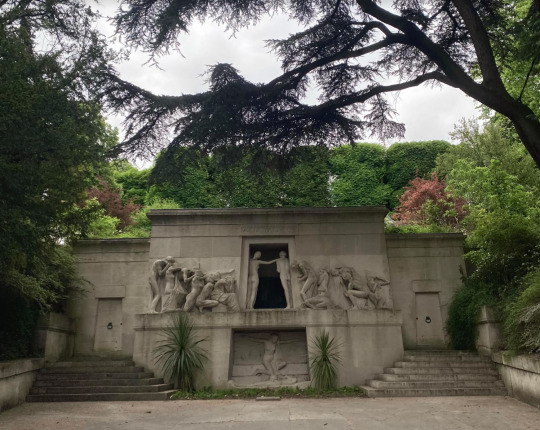
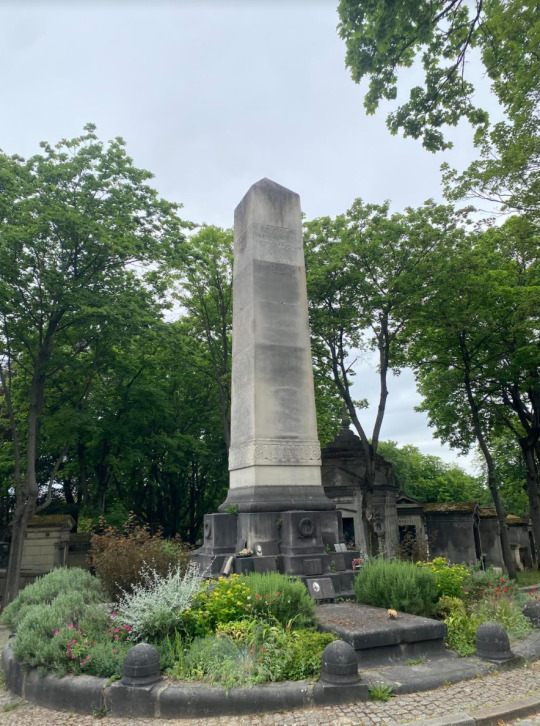

For the most part, I really enjoyed exploring the cemetery. At the beginning of my trip, I felt a little stressed and uneasy, as the expansive cemetery was very difficult to navigate, and it felt a little creepy to me. Also, it felt very strange to me that the resting place of so many people was being treated more like a tourist attraction. However, after a little trial and error (and a lot of studying the map), I was able to figure out the winding pathways and different districts of the cemetery better, and I began to feel a little more comfortable and was able to appreciate the beauty and history more. It was so cool to see all the different types of tombs / graves and how they were unique to each family or person that was buried there, and if they featured different religious depictions or not. For example, Oscar Wilde’s grave contained a book. Another thing that I found super interesting was seeing graves from the early 1800s right next to graves from the 21st century, which really goes to show the deep history of the city of Paris. It was also so cool to see different historical figures buried next to more unknown families as well.

One of the graves that I was most excited to see in my time at Pere Lachaise was the grave of Georges-Eugene Haussmann. Haussmann is responsible for the redesign of Paris. He made the city what it is today by bulldozing large parts of the original city and transforming it to have more wide tree-lined streets, axial perspective, and more modern "Haussmann style" apartments. I was so excited to see his family's because after experiencing the beauty of Paris and learning so much about him in class, I wanted to visit the memorial of the person responsible for much of that. Compared to surrounding graves, I found the Haussmann grave to feel a little more understated, which surprised me for such an important figure, but it was beautiful nonetheless.
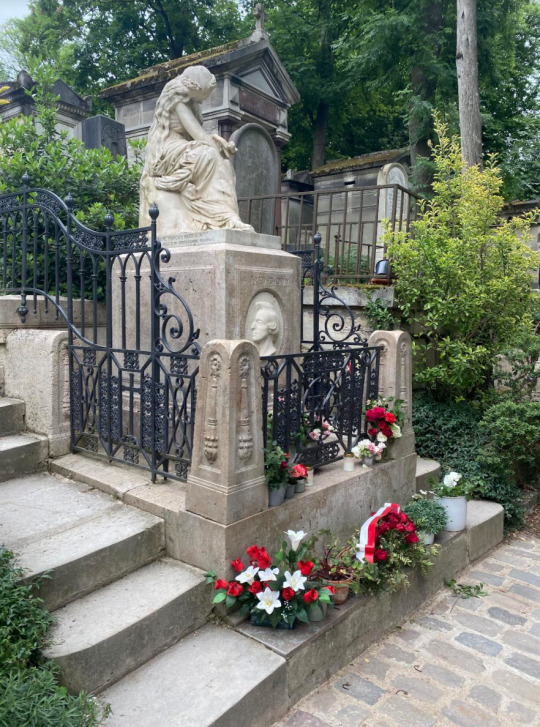
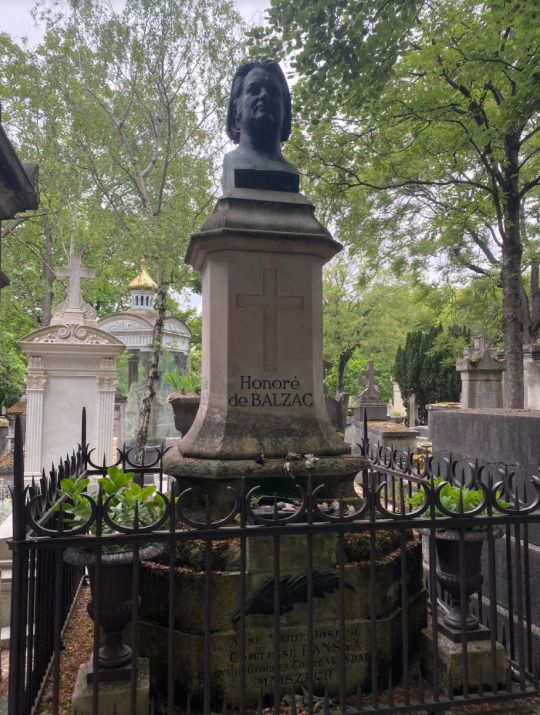
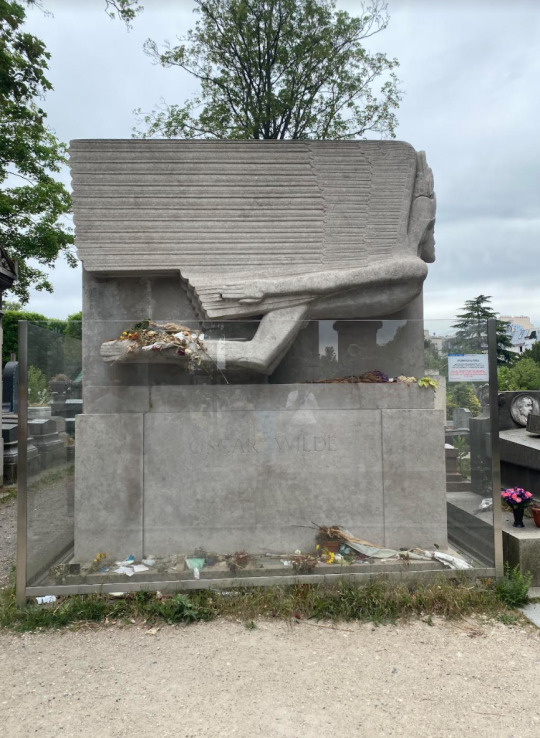
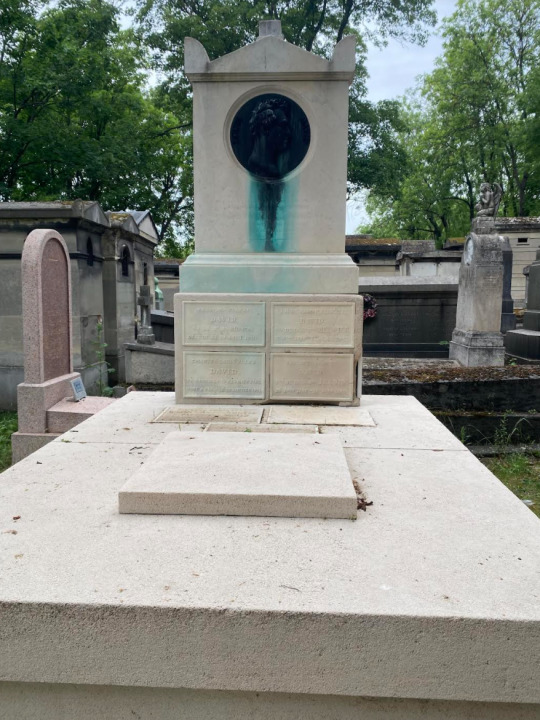
Some more historical graves that was able to visit include Chopin. David, Oscar Wilde, Balzac, and Jim Morrison. I loved being able to honor their memory in this gorgeous historical cemetary!
Sources:
Paris City Guide
0 notes
Photo

Cimetière du Père Lachaise, le 9 novembre dernier, centenaire de la mort d’Apollinaire.
2 notes
·
View notes
Photo
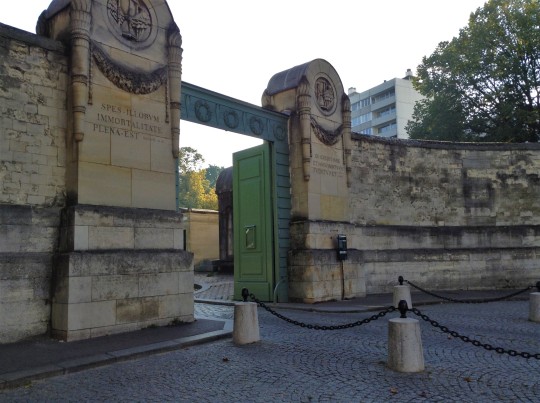
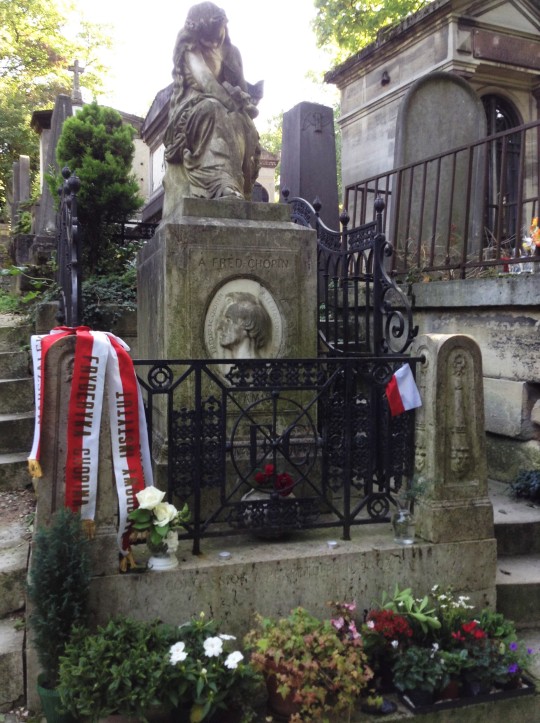

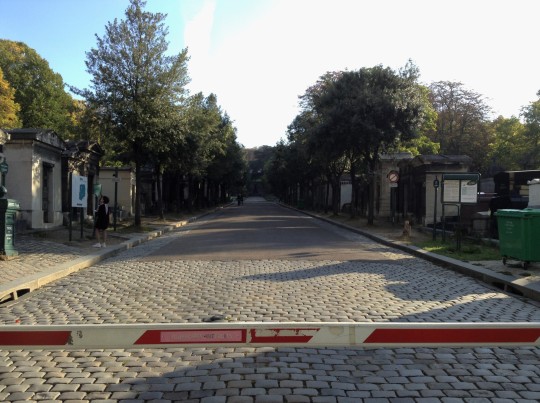


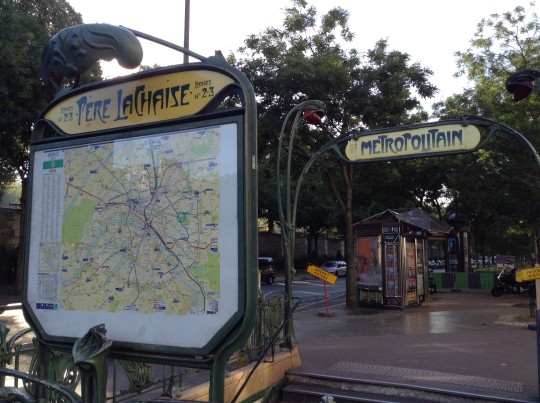
#Père Lachaise#Cimetière du Père Lachaise#pere lachaise#cemetery#oscar wilde#metro#guimard#colette#chopin#paris#paris france#wanderlust#travel#travel photography#dark academia#history#french history
25 notes
·
View notes
Photo
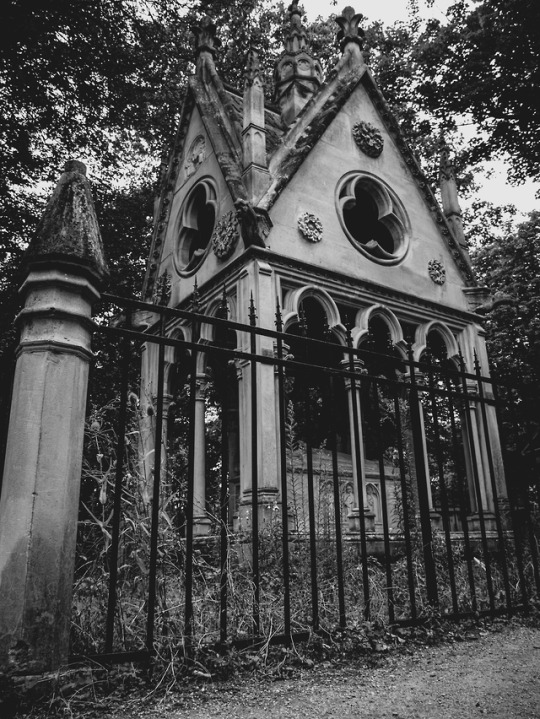
RiP
#rip#rest in peace#cimetiere du pere lachaise#cimetière#pere lachaise#pere lachaise cemetery#city#tomb#tombe#paris#black and white#truk2kent#lumixg7#lumixg7shot
5 notes
·
View notes
Photo
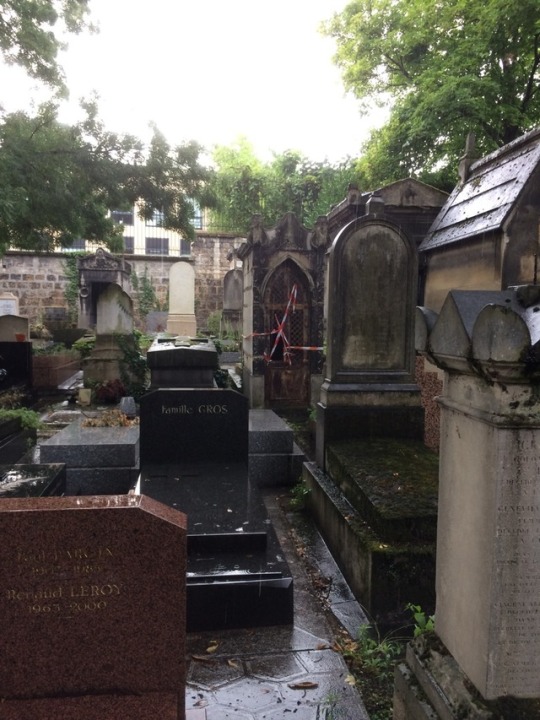





#cemetery#Paris#spooky#horror#graves#graveyard#crypt#france#Europe#pere lachaise#pere Lachaise cementary#cimetière#cimetiere du pere lachaise#goth#gothic#emo#cimetière du père lachaise#père lachaise#death#scary#crucifix#aesthetic#aestheitcs#burial
4 notes
·
View notes
Photo

© Audrey Serra 2017
28 notes
·
View notes
Photo

Le cimetière du Père Lachaise
Situé dans le 20ème arrondissement de Paris, le cimetière du Père Lachaise est une institution : Plus grand cimetière parisien intra muros, véritable musée en plein air de la sculpture funéraire française, son histoire est intimement liée à l’histoire de Paris et à celle de la France (Les campagnes de Bonaparte en Égypte, la Commune de Paris, 1871). Plus encore, le Père Lachaise est le champ de repos le plus célèbre de la capitale par le nombre de personnalités politiques, scientifiques, artistiques, littéraires qui y sont inhumées.
https://haztufocotemporal.wordpress.com/2020/03/12/le-cimetiere-du-pere-lachaise/
6 notes
·
View notes